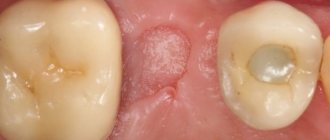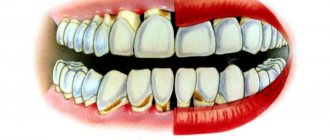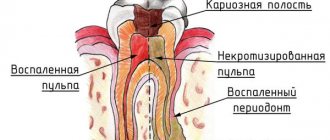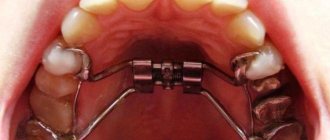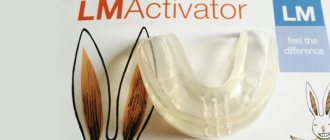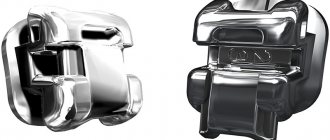Ideal state parameters
The aesthetic characteristics of the oral cavity depend on several basic parameters:
- the presence of a clear contour on the gums of the central incisors;
- location of the gingival contour of the lateral incisors (1 mm lower than that of the central units);
- harmonious combination of the smile line and gum contour;
- insufficient height of the coronal part (less than 1.1 cm).
If one of the above conditions is violated, attractiveness decreases. In this case, correction of the deficiency is required.
One of the effective ways to eliminate a defect is to lengthen the tooth crown.
Procedure methods
Dentistry offers 3 main methods of crown lengthening, all of them using modern technologies and materials:
- Orthodontic – gradual pulling of a tooth from the bone using a special system of braces. Can be installed on a single tooth or the entire jaw. The disadvantage of this method is the long period of wearing the system.
- Therapeutic – lengthening of teeth using composite material, suitable for single teeth or small chips. This method is relatively inexpensive and fast, and it does not require complex dental procedures.
- Orthopedic – crown extension using special artificial structures. It is used in the presence of a diagnosed worn edge of a tooth, as well as in the process of restoring minor chips to restore the aesthetics of the external beauty of a smile.
There is a more radical way - surgical. It involves surgically removing part of the gum and giving a new shape to the contour of the gums. It is used in aesthetic dentistry to restore the external contour of the dentition. Surgery is performed under local anesthesia.
Indications for correction
There are 4 types of indications for which incisor enlargement is prescribed:
- restoration;
- functional;
- orthopedic;
- therapeutic.
In the first case, the procedure is carried out to give the bone organs their original external characteristics.
During the procedure, visible defects are eliminated - chips and cracks in the enamel. Restoration is carried out using veneers or a filling composite.
For functional indications, it is necessary to make the elements longer for aesthetic reasons.
With a defect, the contours of the face change and discrepancies in the length of the elements of the dentition and its proportions are noticeable. The problem is often observed in people whose gums protrude strongly when smiling due to the small size of the units.
Another indication of a functional nature is increased abrasion of the enamel, as a result of which the coronal part of the unit is shortened.
According to orthopedic indications, 1-2 elements are lengthened. Orthopedic traction is performed using braces and requires a long correction time. Therefore, this method of correcting a defect is prescribed in rare cases.
If there is a chip on the anterior fragments, therapeutic restoration may be prescribed.
The height of the damaged fragment is restored using a filling or ceramic veneer.
Let's figure it out: hemisection of a tooth is an operation to remove a cyst or part of its root.
Let's talk here about indications and contraindications for tooth replantation.
This address provides detailed information about the pros and cons of alveolotomy.
What is crown lengthening?
Lengthening the crown of a tooth usually means surgical intervention. It consists of raising the gum level and creating a new gingival contour. In addition, there are three more lengthening techniques:
- Orthodontic
. It involves installing braces on one tooth or the entire jaw. Most often it is used to “pull” one unerupted tooth from the bone. The main disadvantage is the duration of wearing. The braces system will have to be worn for 2-3 years. - Orthopedic
. Uses thin orthopedic plates - veneers and lumineers. It is used for abrasion of the cutting edge and reconstruction of chipped, defective teeth. The method does not involve the gum area, the bite is raised; - Therapeutic
. This is a composite build-up on the cutting parts of single teeth. Used to correct teeth with minor chips and chips.
The method is chosen by the dentist, depending on the diagnostic results. If the patient’s main problem is low receding gums, he chooses the surgical method. If the patient has an ideal gingival contour, an orthopedic or therapeutic method is used.
Possibilities of teeth extension
Using one of the methods of teeth extension, it is possible to change their size and shape. Thanks to extensions, the dentist is able to make teeth longer and wider. By lengthening your front teeth by 1–3 mm, you can get an amazing result - the updated smile area will make you look younger overall. Also, extensions will save the beauty of the front part of the teeth in case of injury, when single chips occur. In this case, the tooth is restored to its normal size and is no different in appearance from its neighbors. Among other things, with the help of extensions you can not only lengthen your teeth, but also make them wider to eliminate unattractive gaps in the dentition.
Indications for testing
- Aesthetics. When there is a discrepancy between the height of the gums and the teeth, when the gums are very noticeable when smiling, and the teeth appear small.
- Restoration. Lengthening allows you to restore an anterior crown due to a chip or caries using a filling or veneers.
- Functionality. It is carried out in case of pathological abrasion of teeth in order to restore the length of the tooth.
- Treatment. Performed in the complex treatment of periodontal diseases to remove periodontal pockets.
This is interesting: How to kill and calm the dental nerve at home in a tooth
Are there any contraindications to lengthening?
Sometimes, after diagnostic tests, the dentist recommends that the patient refuse the procedure. This happens in the following cases:
- The operation may negatively affect the aesthetics and functionality of adjacent teeth;
- The efforts and material costs for lengthening do not correspond to the predicted result and are not in favor of saving the tooth;
- Restoring a tooth is impossible even if surgery is performed to lengthen it;
- The distance between the bottom of the gingival groove and the bone crest is less than 3 mm;
- The root of the tooth, the crown of which the patient wishes to lengthen, is not long enough.
Contraindications
Each treatment method has its own contraindications, including lengthening of bone organs. Surgical intervention is not recommended if access to the problem area is difficult.
For example, the side elements cannot be extended because they are difficult to access. Also, surgery is contraindicated if the gum contour is ideal, because after the intervention the aesthetic characteristics of the smile deteriorate.
You should know! To carry out the procedure, it is necessary that the ratio of the crown part to its root does not exceed 1:1. That is, surgical lengthening is not suitable for patients with small roots.
If surgical lengthening is contraindicated, the patient is offered alternative intervention techniques, for example, implantation.
In this case, the defective element is removed from the oral cavity, and an artificial prosthesis is implanted in its place.
Among the general contraindications to incisor enlargement are:
- viral and infectious diseases occurring in the acute stage;
- chronic pathologies of the cardiovascular system;
- dysfunction of the hematopoietic system;
- inflammation of the mucous membranes of the mouth.
What factors need to be considered when surgically lengthening a tooth crown?
Surgical intervention aimed at correction in the frontal region must be carried out perfectly, since any mistake will lead to noticeable cosmetic defects. In addition, it is important to exclude any effect of the operation on the stability of the tooth.
That is why surgical lengthening of the crown of a tooth is preceded by careful preparation. The patient must undergo a series of diagnostic tests, which includes examinations by a periodontist, an orthopedist and a surgeon, as well as a 3D computed tomography scan. The latter is necessary in order to determine the length at which the tooth roots are located and to assess the condition of the jaw bone tissue.
When planning an operation, the following factors are taken into account:
- The current state of periodontal tissues, the forecast of their condition for the future;
- The distance between the bottom of the gingival sulcus and the bone crest: it must exceed 3 mm in order to guarantee the stability of the tooth;
- Aesthetic component;
- Anatomical features of the anatomy of dental roots, the ratio of the length of the coronal and root parts: the root part cannot be smaller than the coronal part;
- Condition of the jaw bone.
This is interesting: Why did bad breath appear after tooth extraction and how to get rid of it?
Preparing for surgery
The procedure requires preliminary preparation. The patient needs to take care of his health in order to endure the postoperative period without complications.
The doctor must collect all information about the patient to identify any contraindications to the procedure.
Preparation for surgery begins with an initial examination of the oral cavity. During the consultation, the specialist warns the patient about possible complications and informs about treatment tactics.
Before the operation, you need to undergo a number of laboratory and instrumental examinations:
- CBC (complete blood count) to identify abnormalities in the functioning of internal organs , which may become a contraindication to the procedure. If there are any pathologies, the operation is postponed until complete recovery.
- X-ray and CT. The examinations allow the specialist to assess the condition of the patient’s bone structures and the location of the nerve endings.
Based on these parameters, the doctor determines the optimal treatment tactics. In some cases, the patient is recommended methods alternative to surgical augmentation of the incisors. - Sanitation of the oral cavity. Before intervention, it is necessary to remove carious cavities or pathological roots in order to minimize the risk of infection of the surgical field.
- Professional cleaning. The event ensures sterility during the operation.
Before intervention, the doctor must perform the following measures:
- remove all carious cavities;
- establish the presence of allergic reactions in the patient to the materials used;
- treat inflammatory diseases of the mucous membranes of the mouth.
A few days before the procedure, patients are advised to:
- stop smoking and drinking alcohol;
- include foods rich in calcium in your diet - eggs, cheese, milk;
- avoid excessive physical activity;
- stop taking medications that thin the blood;
- thoroughly clean your teeth and tongue from food debris;
- treat the oral cavity 3 times a day with antiseptic solutions.
Important! On the day of surgery, they refuse to eat. Consumption of tea and water is acceptable.
Surgical intervention
During the classic operation, the periodontal sulcus is excised. This procedure is associated with risks of postoperative complications, because the damaged anatomical formation is responsible for the immunological and protective function in the oral cavity.
Recently, surgical lengthening of teeth is performed using modernized technology, in which the gum margin is not removed. This type of intervention is considered the fastest and safest way to lengthen incisors.
Surgical lengthening is performed in 1 day. The duration of the procedure depends on the amount of work. To lengthen each element, a specialist takes on average up to 10 minutes.
1 week after surgery, temporary prostheses are installed. They are necessary for the formation of an anatomically correct gum contour.
Permanent structures are installed 3-5 months after surgery. This time is enough for the final formation of the gums. Orthodontic treatment lasts from 8–12 months.
The purpose of dental cystotomy and the expected result.
In this publication, we will calculate the cost of complex wisdom tooth removal.
Here https://zubovv.ru/hirurgiya/udalenie-zubov/atrofii-alveolyarnogo-otrostka.html all the most important things about alveolar process atrophy.
Recovery
The operation rarely causes complications. Among the consequences of the operation, allergic reactions to materials and pain in the area of intervention should be noted.
To minimize the risk of adverse reactions in the postoperative period, you should follow some rules:
- Do not eat after the procedure for 2 hours. Then preference is given to soft, crushed products.
- Chew food in side units.
- Apply Solcoseryl paste to the treated area.
- Avoid using medications containing calcium.
After surgery, swelling and bruising may appear in nearby soft tissues. For this reason, it is recommended to apply a cold compress to the treated area for 5 minutes for the first 2-3 days.
Important! In the postoperative period, it is necessary to avoid physical overload and stop eating spicy foods.
Rehabilitation period after surgical tooth lengthening
Any surgical intervention may be accompanied by complications. It is important for the patient to comply with all the doctor’s requirements to avoid tissue infection. If the gums become inflamed, the healing process will be delayed, and the aesthetic result may be lower.
It is necessary to exclude spicy, sour, hard foods that can irritate or scratch injured tissues. Do not put too much stress on the central incisors or canines (gnaw hard foods). Smoking is prohibited as it impairs wound healing.
It is not recommended to overheat the body, so going to the bathhouse or the beach or taking a hot bath will have to be postponed. You cannot engage in sports or heavy physical labor.
Medical recommendations must be followed for 2 weeks. At this time, hygiene procedures are carried out with extreme caution, avoiding the operated area. It is necessary to rinse the mouth with antiseptic agents: Chlorhexidine, Romazulan, Miramistin, a weak solution of manganese or other antiseptics.
For pain, take analgesics. You can apply ice to the projection of the correction area. A cold compress will relieve swelling and reduce pain. In some cases, your doctor may prescribe antibiotics.
Alternative techniques
In addition to the surgical method of increasing bone tissue, there are other alternative methods:
- Orthodontic. Used to increase the size of one unit.
For this purpose, corrective devices are used that are attached to one area of the oral cavity or fixed along the entire length of the jaw. The duration of therapy varies from 3-12 months. After correcting an element with orthodontic structures, the installation of removable retainers is required to secure the treatment result. - Orthopedic. The essence of the method is to build up the fragment using veneers, lumineers or artificial crowns. The main advantage of the method is the absence of excision of soft tissue.
Only the cutting edges undergo correction. This type of correction is used when numerous elements are damaged or when there are chips and cracks in the enamel.The method can be prescribed to patients with an ideal gum line, while other methods are contraindicated in this case.
- Therapeutic. Regrowth of the cutting edge occurs through the use of composite materials.
The therapeutic method is prescribed if correction of 1 or 2 units is necessary. The advantage of the procedure is minimal trauma to soft tissues and bone structures.
What methods are used for lengthening?
Modern dentistry offers various techniques for lengthening the crown of a tooth. Their selection is carried out on an individual basis depending on the patient’s indications.
| Method | Indications for use | How is it carried out? |
| Orthodontic | It is necessary to lengthen the crown of one tooth | Involves the use of braces, which must be worn for at least two years. |
| Orthopedic | Weared cutting edges of crowns, significant defects of decayed teeth, short teeth with the correct gingival contour. | It consists of building up with the use of veneers or crowns, which as a result raises the bite without involving the gingival area in the process. |
| Therapeutic | Chip of one tooth. | Provides for the restoration of the coronal part of the tooth by increasing the cutting edge using special composite materials. |
| Surgical | Gummy smile, the need to raise the gum level and give it the desired line. | An operation is performed to remove part of the bone and gum tissue and form the gingival contour of the desired shape. Depending on the clinical indications, bone resection, gingivoplasty or gingivectomy are performed. |
Extension with photopolymers
Lengthening teeth using filling materials and photopolymers shows high efficiency. This material allows the dentist to gradually form the desired tooth shape in layers. This is a very painstaking artistic work that helps eliminate damage without a trace. Once the work is completed, a special light is directed onto the tooth to completely harden the photopolymer. Grinding gives the teeth their final appearance. The hardened photopolymer is indistinguishable from enamel either in color or in surface microrelief. It is even stronger than enamel and can last for many years. The only difference between the composite is its higher porosity. This means that after teeth extensions it is necessary to attend professional oral cleaning procedures so that the photopolymer does not change its color.
Extension with veneers
Veneers are suitable for lengthening teeth in the front part of the mouth. These are the thinnest ceramic plates that are glued to polished teeth. It is possible to choose any color of veneers so that they do not differ from other teeth. They can also be given the necessary shape for maximum naturalness. Veneers are the best helpers for thinning enamel, chips, microcracks and gaps between teeth. Thanks to veneers, a truly Hollywood smile is created.
Extension using crowns
Often it is not only the front teeth that need to be lengthened, but also the chewing ones. A crown is usually used for this. Crowns are suitable if the tooth is significantly damaged by caries, but not destroyed. To place a crown, the tooth is prepared and then an impression is taken of it for a custom laboratory crown. After installing a metal-ceramic or ceramic crown, it is also no different from natural enamel.
Extension using pins
In the case where the crown is destroyed to the base, but the root of the tooth is preserved, the tooth is built up using a pin. To do this, a metal rod is installed in the root canal, and then composite materials are applied to it layer by layer. Thus, the pin becomes the basis for the crown. Among the disadvantages of this method is the high risk of secondary caries around the pin, so the use of the pin is gradually being abandoned in favor of more advanced technologies.
The choice of lengthening method depends on the degree of tooth destruction, the nature of the damage and other factors. To find out which method of teeth extension is suitable in your case, contact the specialists of the French Dental Clinic. They will provide you with comprehensive advice and offer the best solution to the problem.
This is interesting: How much does the jaw hurt after tooth extraction - why does this happen and what to do
Price
The price of interventions depends on several criteria:
- technology of the operation;
- specialist qualifications;
- dental center where the procedure is performed;
- equipment used.
The cost of the operation depending on the technique is presented in the table.
| Method | Unit price (in rubles) |
| Surgical | 5000 |
| Orthopedic | From 8000—30000 |
| Therapeutic | 5000 |
The video provides additional information on the topic of the article.
Reviews
Teeth lengthening is performed in order to hide minor defects in the row, including their disproportionate sizes.
The specialist selects the optimal intervention option depending on the characteristics of the problem. Share your experience in lengthening incisors in the comments to the article.
If you find an error, please select a piece of text and press Ctrl+Enter.
Tags tooth lengthening surgery
Did you like the article? stay tuned
No comments yet
Preparation
Regardless of the technique used to perform the incisor lengthening operation, the first step to performing it is to prepare the patient’s oral cavity for the proposed manipulation.
First of all, the dentist carries out a thorough examination of the patient’s teeth and gums, determines the presence of concomitant diseases - carious lesions, inflammation of soft tissues.
During the examination, the following points are also assessed, allowing you to correctly draw up a surgical plan:
- aesthetics of the patient’s smile, proportions of all elements of the jaw row;
- condition of periodontal tissues;
- the structure of the root system and the relationship between the length of the roots and the height of the bone organs;
- condition of the jaw bone tissue.
In addition to consulting a dental therapist, when choosing an intervention method and drawing up a surgical plan, you may need to consult related specialists - periodontist, surgeon, orthodontist, orthopedist.
Of the instrumental examination methods, the most commonly used is computed tomography , which allows one to assess the length and location of the roots, as well as the condition of the bone tissue.
The final procedure of the preparatory stage is professional cleaning and sanitation of the oral cavity , which eliminates the existing infectious process and prevents the risk of infection of the surgical field.
